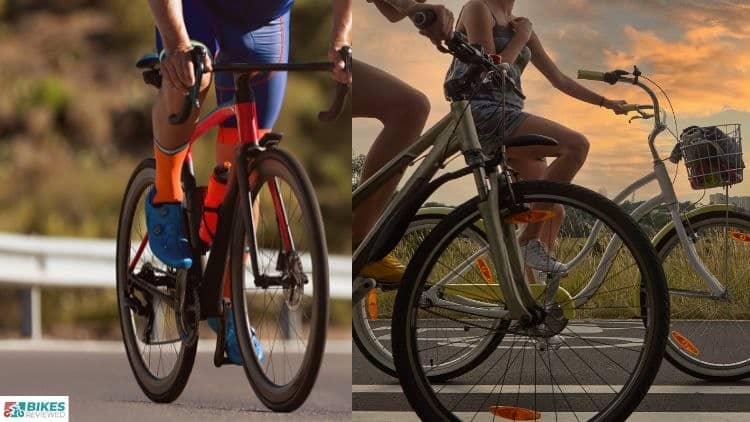The choice between a men's and women's bike goes beyond just aesthetics. Each variant is meticulously crafted to accommodate the unique anatomical and biomechanical differences between the genders, ensuring a tailored riding experience.
Let's embark on a journey through the nuanced disparities between men's and women's bikes, uncovering valuable insights for both novice and seasoned cyclists.

1. Saddle Sensibility:
The first and most noticeable difference lies in the saddle. A woman's pelvic structure generally demands a wider seat to provide adequate support for the sit bones. Men's bikes, on the other hand, often feature a narrower saddle, catering to the typically narrower pelvic structure of men. This subtle but crucial detail significantly enhances comfort during prolonged rides
"In the world of cycling, comfort is key. A well-fitted saddle can make the difference between a leisurely ride and an arduous journey."
2. Frame Geometry:
Frame geometry plays a pivotal role in dictating the riding posture and comfort level. Women's bikes typically have a shorter reach and a higher stack, facilitating a more upright riding position. This design is considerate of women's generally shorter torsos and longer legs. Men's bikes, in contrast, tend to have a longer reach and a lower stack, encouraging a slightly forward-leaning posture suitable for their physiological makeup.
"Your bike should be an extension of your body, not a challenge to it. The right frame geometry ensures a harmonious blend of comfort and efficiency."
3. Handlebar Width:
The width of the handlebars is another area of divergence. Women's bikes often come equipped with narrower handlebars, acknowledging that women, on average, have narrower shoulders than men. This feature ensures a more natural and comfortable grip, enhancing control and maneuverability.
4. Crank Arm Length:
The length of the crank arms can significantly impact pedaling efficiency. Women's bikes generally feature shorter crank arms, recognizing that women often have proportionally shorter legs than men. Shorter crank arms contribute to a more fluid pedal stroke, reducing the risk of strain and discomfort.
5. Braking Power:
Considering the differences in average upper body strength between men and women, braking systems are calibrated accordingly. Women's bikes may have brake levers with a shorter reach, making it easier for individuals with smaller hands to apply sufficient braking force comfortably.
Cycling is not just a physical exercise; it's a dance between man and machine. The right adjustments ensure that this dance is both graceful and powerful.
6. Frame Material and Weight:
While not strictly gender-dependent, the weight and material of the frame can impact the overall ride experience. Women's bikes often feature lighter frames, recognizing that, on average, women tend to be lighter than men. A lighter frame contributes to easier handling and maneuvering, especially for riders with less upper body strength.
In the world of cycling, where the harmony between rider and machine is paramount, the distinction between men's and women's bikes is more than cosmetic. It's a thoughtful consideration of physiological differences that, when addressed, can elevate the cycling experience. Remember, a well-informed choice of bike not only enhances performance but also ensures a more enjoyable and sustainable journey on two wheels.
"Choosing a bike is not just about the destination; it's about the ride. Find the one that resonates with your body, and every journey becomes an adventure."
As you delve into the fascinating realm of cycling, keep these distinctions in mind. Your choice of a bike is a personal statement, an acknowledgment of your unique anatomy and riding style. Whether you're navigating urban landscapes or conquering mountain trails, the right bike is your trusted companion, propelling you toward new horizons with every turn of the pedal.
Key Lessons for the Avid Rider
Now that we've explored the nuances between men's and women's bikes, let's distill some essential lessons that transcend gender-specific designs. These insights serve as beacons for any cyclist seeking not just a mode of transportation, but a partner in their journey.
Comfort is Non-Negotiable:
Regardless of gender, prioritize comfort. A well-fitted saddle, ergonomic handlebars, and a thoughtful frame geometry contribute to an enjoyable ride. Your bike should complement your body, not challenge it.
Personalized Fit Matters:
Every rider is unique. Whether it's adjusting the saddle height, fine-tuning the handlebar angle, or choosing the right frame size, a personalized fit ensures optimal performance and reduces the risk of strain or injury.
Balance Efficiency with Enjoyment:
While performance metrics matter, don't forget the joy of riding. A bike that feels like an extension of yourself transforms cycling from a workout into an adventure. Balance efficiency with the sheer pleasure of the ride.
Invest in Quality:
A bike is an investment, not just in monetary terms but in your overall well-being. Quality components and thoughtful design pay off in the long run, offering a smoother, more reliable riding experience.
Understand Your Riding Style:
Whether you're a city cruiser, a trailblazer, or a long-distance road cyclist, understand your riding style. Different terrains and purposes demand specific features. Tailor your bike choice to your intended use.
Many riders, regardless of gender, find themselves gravitating towards bikes that align with their unique anatomies and riding styles.
Manufacturers are recognizing this shift, introducing unisex models that incorporate the best features from both categories. As a rider, this opens up a broader spectrum of choices, allowing you to select a bike based on your specific needs rather than adhering strictly to gender labels.
Your bike is more than metal and gears; it's an extension of your spirit on the open road. So, pedal forth with confidence, for the road is yours to conquer.
